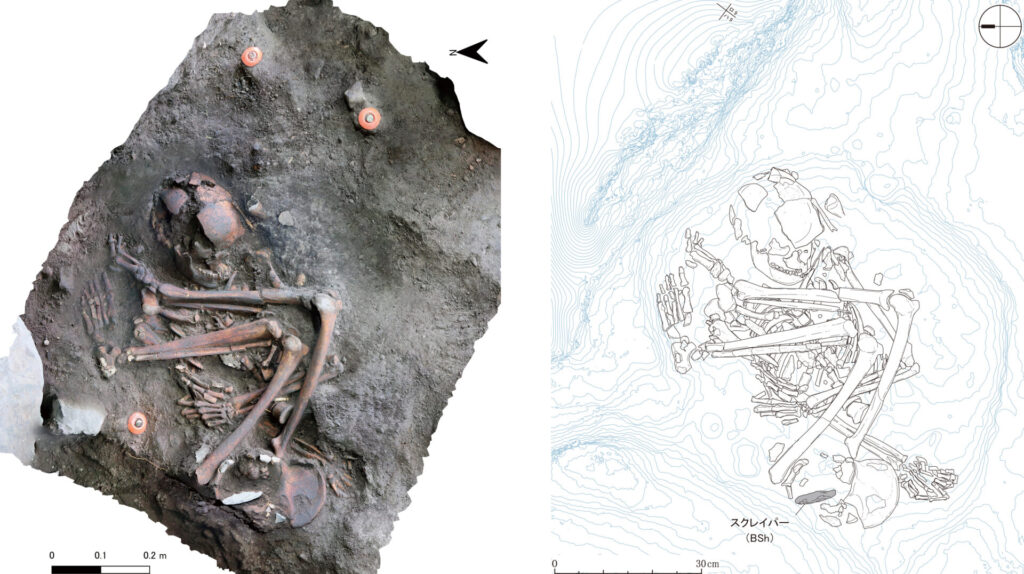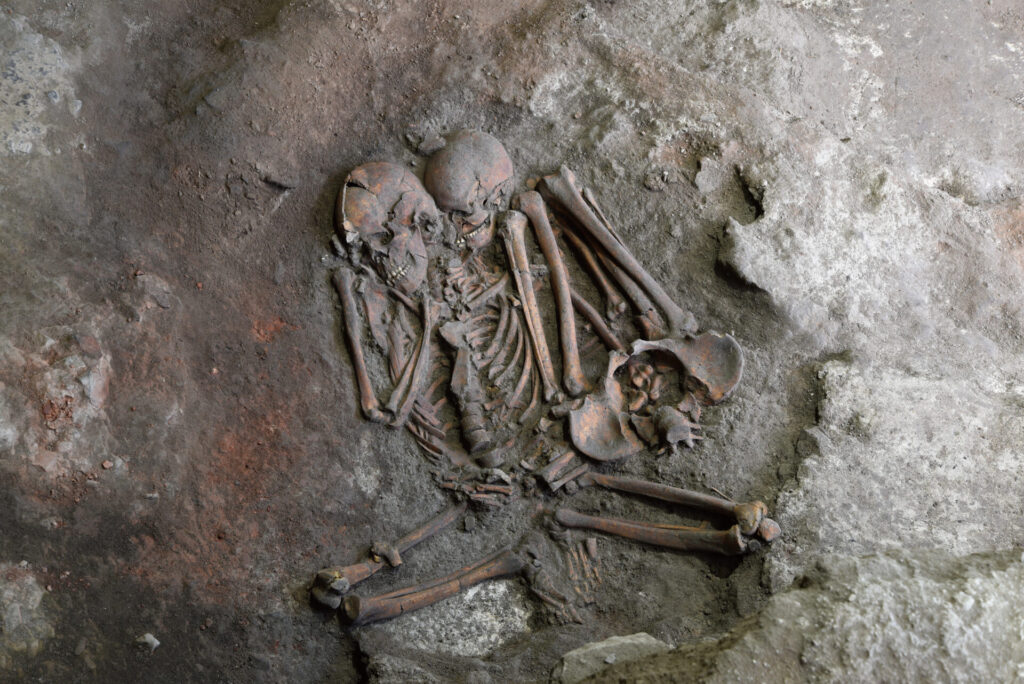Archaeological Investigation of Human Skeletal Remains at the Iyai Rock-Shelter Site
Discovery of Human Skeletal Remains at the Iyai Rock-Shelter Site
As of 2023, excavations at the Iyai rock-shelter site have uncovered the skeletal remains of more than 40 individuals and revealed that the area was used as a burial ground in the Initial and Early Jomon periods. In particular, a large number of individuals were buried in close proximity together in the grayish dark brown soil of Layer II, a stratum containing artifacts dating to the Initial Jomon period (Fig. 1). The results of radiocarbon dating of 15 samples from 11 individuals indicate that the human skeletal remains date to two periods: the Latter part of the Initial Jomon Period (ca. 7300-7700 BP) and the first half of the Early Jomon Period (ca. 5900 and 5700 BP), with eight individuals belonging to the former and three individuals to the latter. Based on calibrated radiocarbon dates, the skeletal remains buried in the ashy soil of Layer II are estimated to date to around 8500-8100 cal BP. The practice of using caves and rock shelters as burial sites (cave/rock shelter burial) became widespread from the middle to latter parts of the Initial Jomon period, particularly from Western Japan to the Chubu and Kanto regions, and the Iyai site is a prime example.
Based on a number of factors, including the fact that the site had been in continuous use for over 300 years, many individuals were buried closely together, relatives with confirmed blood relations were among the individuals buried, and a certain known burial style (see below) was identified, the burials of the Initial Jomon period are considered to have been mass graves. This makes the Iyai rock-shelter site the earliest example of mass graves found in the Jomon period.
Bioarchaeological Analysis of the Iyai Human Skeletal Remains
The human skeletal remains excavated from the interior of the rock shelter are in an extremely good state of preservation as they were buried in ashy soil, and the proteins (collagen) and DNA are well preserved. Bioarchaeological analyses of the materials is currently underway, including morphological analysis, paleopathological analysis, carbon-nitrogen stable isotope analysis, and mitochondrial DNA and nuclear DNA analysis.
The human skeletal remains excavated from the interior of the rock shelter are in an extremely good state of preservation as they were buried in ashy soil, and the proteins (collagen) and DNA are well preserved. Bioarchaeological analyses of the materials is currently underway, including morphological analysis, paleopathological analysis, carbon-nitrogen stable isotope analysis, and mitochondrial DNA and nuclear DNA analysis.
Carbon-nitrogen stable isotope analysis of collagen extracted from 14 bone samples from 12 individuals revealed a trend toward a diet highly reliant on C3 plants. Comparison with data from other Initial Jomon populations elsewhere in the Japanese archipelago will help to clarify the characteristics of the Iyai population and the ecological diversity of the Initial Jomon people.
Carbon-nitrogen stable isotope analysis of collagen extracted from 14 bone samples from 12 individuals revealed a trend toward a diet highly reliant on C3 plants. Comparison with data from other Initial Jomon populations elsewhere in the Japanese archipelago will help to clarify the characteristics of the Iyai population and the ecological diversity of the Initial Jomon people.
Burial Practices During the Initial Jomon Period
Three-dimensional surveying and photogrammetry were used during the excavation of all human skeletal remains to record the details of each individual and to analyse burial techniques (Fig. 3). Some of the skeletal remains of individuals were buried in earthen pits with a bent posture, but several examples were identified where the commissure of the bones had been disconnected at the middle of the lumbar vertebrae, separating the upper and lower halves of the body. There was also a mass burial with the remains of over ten individuals buried in close proximity to one another (Human Mass Burial A, Fig. 4).
An individual burial in which the upper and lower halves of the body were separated was first noted during the investigation of Burial No.1 in 2016. Although the entire skeleton of this individual was near-complete and buried by itself, when the upper part was lifted (lying prone) it became apparent that the upper and lower halves of the body, although in the correct anatomical order, were significantly separated. The third and fourth lumbar vertebrae, which are connected to one another, laid more than 40 cm apart, and the pelvis was located under the head and neck. It was clear that this was an unusual burial, in which the body had been dismembered at the waist. The separated lumbar vertebrae showed no signs of manipulation and there were no cut marks visible to the naked eye. It is therefore highly likely that the upper and lower halves of the body were deliberately dismembered during the drying and mummification process.

An individual burial in which the upper and lower halves of the body were separated was first noted during the investigation of Burial No.1 in 2016. Although the entire skeleton of this individual was near-complete and buried by itself, when the upper part was lifted (lying prone) it became apparent that the upper and lower halves of the body, although in the correct anatomical order, were significantly separated. The third and fourth lumbar vertebrae, which are connected to one another, laid more than 40 cm apart, and the pelvis was located under the head and neck. It was clear that this was an unusual burial, in which the body had been dismembered at the waist. The separated lumbar vertebrae showed no signs of manipulation and there were no cut marks visible to the naked eye. It is therefore highly likely that the upper and lower halves of the body were deliberately dismembered during the drying and mummification process.
Importance of the Iyai Human Skeletal Remains
The origins and phylogeny of the Jomon people have not yet been determined, either anthropologically or archaeologically. Moreover, nothing is yet known with certainty about the social organization of the Initial Jomon – their kinship, marriage systems and overall group structure. It has also been difficult to determine the health status, life span, and life history from birth to death of the Early Jomon people, who formed the Jomon culture.
Relatively large numbers of human skeletal remains from the Initial Jomon period have previously been discovered at the Iwashita Cave site in Nagasaki Prefecture, the Hegi Cave site in Oita Prefecture, and the Kamikuroiwa rock shelter site in Ehime Prefecture, but the excavations were conducted many years ago and there is very little documentation on the burial conditions to use as comparative data. The human skeletal remains from the Iyai rock-shelter site were buried in a layer of ashy soil that had accumulated inside of the rock shelter, and are in an exceptionally good state of preservation, retaining not only the bone structure, but also collagen and DNA. The human skeletal remains from the Iyai rock-shelter site are therefore a primary source of anthropological information on the Initial Jomon period people, providing invaluable scientific information on the origin and descent of the Jomon peoples, as well as their morphological and regional characteristics including health conditions and individual life histories. In addition to the excellent state of preservation, the burial conditions of the remains are clearly defined and include a mass grave buried by the same group of people. DNA analysis of the remains enables us to investigate not only the anthropological characteristics of the Initial Jomon people, but also to determine the kinship relations between individuals and the overall group structure.
Yasuhiro Taniguchi




